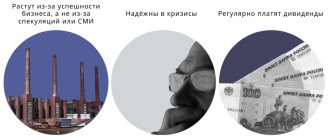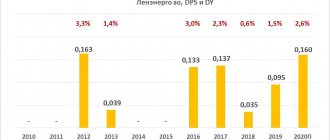Right now, investors will be able to find a large number of structures in which they can invest their money and multiply it. One of the most interesting options is investing in innovation. This word means any new technology that should improve the lives of ordinary people, and at the same time bring dividends to the reader. But is this as good as it seems at first glance, and what pitfalls exist? This is what we have to find out right now.
The place of innovation in investment practice
Innovation should be understood as a complex of inventions, innovations and innovations in the material or intellectual sphere, which is the result of people’s creativity, brought to the stage of a commercial or other new product. Innovations are carried out in the field of engineering and technology, management and organization. Such innovations can significantly change the market position of the investee due to obvious advantages over competitors. Their main goal is to ensure future economic benefits. The expected benefits significantly exceed the effects of traditional investments typical for the relevant industry. Innovation has three fundamental dimensions that need to be taken into account.
- The presence of the creative process, which is the basis of inventions and innovations.
- Distinctive novelty of innovation.
- The result of innovation is the generation of additional income, which is subject to evaluation.
The formalization of these parameters for the purposes of objectivity and authenticity of innovation is essential. The concept of the creative process is closely related to the systemic phenomenon of the problem, which takes the form of manifested and hidden difficulties and opportunities. They cover the areas of management, commodity, intellectual products presented on the market and in society. Identification of root problems and opportunities occurs as a result of research that is based on a scientific approach. R&D budgets serve as a quantitative measure of stakeholders' investments in research as part of the creative process of innovation.
The formal character of distinctive novelty is given by obtaining a patent for an invention. This fact confirms its uniqueness and rights protected at the state level. A secondary effect of patent registration is the originality of the new idea and development. New income, which is generated as a result of introducing the results of an invention into the practice of business or other public institutions, records in a quantitative format the fact of the usefulness of the innovation. Income serves as the “watershed line” between invention and implemented innovation. Generated income is a complex category and implies the following benefits:
- increase in profit;
- increasing the company's market share;
- cost reduction;
- royalties under a commercial concession agreement;
- license fees.
Investments and innovations are closely interrelated categories that describe processes of investment of funds that are identical in economic nature and are carried out with similar goals. Innovative projects are special cases of investment project tasks, for which economic efficiency is predicted at significantly higher levels. At the same time, the risk component for innovative investments is significantly higher, which, in Russian conditions of a weak market, hinders their development.
Research results
Dealing with the problems of pricing for various goods and benefits, representatives of marginalism conclude that prices influence the process of capital accumulation and its investment. Having developed an algorithm for estimating the value of present and future benefits of the capital owner (investor), they show the mechanism for the emergence of the marginal efficiency of capital. Using a completely different research methodology, namely, the tools for analyzing marginal values, marginalists formulate the key principles for constructing microeconomic investment models.
Within the framework of the positive theory of capital, O. Böhm-Bawerk understands the latter as a set of funds “productively used for roundabout methods to increase the quantity of goods in the future, which can take such forms as commercial, industrial and loan capital” [6].
The investment process described by O. Böhm-Bawerk clearly demonstrates that the ideas of researchers at the end of the 19th century are based on fundamentally different approaches, according to which the sphere of consumption is given a leading role, including in the process of forming investment sources. The key form of income is interest, which permeates all economic relations, serving as a link between the present and the future. An increase in the rate of income, which contributes to the expansion of investment opportunities, is a consequence of scientific and technological progress.
Fisher, studying the nature of capital and interest, believes that their emergence is associated with the process of pricing, determined by the size of the money supply. Thus, we can conclude that, according to I. Fischer, investments can also arise in the sphere of circulation. [2]
The argument that investment is a function of the rate of interest, and of a decreasing nature, is also reflected in the works of A. Marshall. The founder of neoclassicism, the core of which is J.B. Say’s position on the equality of supply and demand, considers the principle of equilibrium through the categories of investment and savings. Accumulation in the ideas of A. Marshall is the source of the birth of savings, which are formed as a certain excess of income received from the sale of various factors of production. In his opinion, you can save from wages, rent, and profit. In the short run, savings lead to an imbalance between production and consumption. But thanks to the financial market, the size of planned investments can be equal to the amount of savings. The interest rate is a balancing mechanism between savings and investments, regulating their value. It is clear that this is an ideal model, which is unrealizable in practice. [3]
Another representative of the neoclassical movement, A. Pigou, more closely links the investment activity of business entities with the amount of money in circulation. If, according to I. Fisher, equality in the economy is ensured by the supply of money, then A. Pigou talks about money demand as a factor of equilibrium, which makes his theory more realistically reflect the motivation of economic entities in the process of accumulating savings and investments. The liquidity preference coefficient introduced into the exchange equation by I. Fisher clearly illustrates the degree of influence of accumulation on the investment activity of the authors.
Neoclassical theories are characterized by a synthetic approach to the study of the investment process; they study not only the objective factors of the formation of real investments, but also the subjective, often irrational motives for carrying out investment activities by macroeconomic agents, while using the methodology of equilibrium analysis. It should be noted that within the framework of the neoclassical approach, questions of the formation of macroeconomic investment models are beginning to be raised, but they are based on microeconomic analysis. The authors, using the analogy method, transfer the ordinal functions of utility and productivity to the macroeconomic level, completely depriving it of specific patterns. [4]
A fundamentally different position in his works is taken by J. M. Keynes, who is rightfully considered the founder of the macroeconomic approach to the system of social reproduction. A distinctive feature of his research is the widespread use of the aggregation method, which he extends not only to quantitative parameters, but also to the functional characteristics of business entities. J.M. Keynes identifies four key macroeconomic entities, which include households, firms, states, and the foreign economic sector, which have different motives for investing and saving. In a closed economy, free from government intervention, the balance of savings and investment is ensured by only two units - households and firms, the behavior of which is subject to strictly regulated parameters and can be characterized by specific types of economic activity. The money market is not able to convert all savings into investments, since macroeconomic entities such as households and firms have different motives for their investment. The economic behavior of households and firms does not correspond to neoclassical ideas about a single-factor function of maximizing utility or profit, since participants in the investment process are guided by different ideas about the possibilities, methods of investment and the factors that determine it. [5]
The analysis of savings motivations and investment demand motivations is an innovation of Keynesian theory. Revealing the systemic relationships between aggregated variables, J.M. Keynes demonstrates how the economic behavior of subjects influences the final results of the transformation of savings into investments. In contrast to the views of the classics and neoclassics, for whom an economic actor is an optimizer of his own benefit, for Keynes he is a living person, with certain psychological characteristics, with the possibility of irrational behavior, which affects his investment decisions. It is important to understand that the supply of resources (savings) is not automatically capable of generating investment demand; savings will turn into investments only if many factors coincide, since the processes of savings and investment proceed differently in space and time.
J. Keynes considers investments in the real sector of production, the key motive is the business’s expectation regarding the future return on investment, which he calls the marginal efficiency of capital [7]. He notes that the future is uncertain, however, he does not connect uncertainty with the concept of risk, meaning only that it is conventional, and, therefore, there is no automatic mechanism that guarantees profit. He studies the investment process in dynamics. While neoclassical economists consider household savings to be the source of investment, that is, the share of income that they intend to capitalize, Keynesian theory assumes a different system of interaction between economic entities. Savings do not automatically lead to an increase in the level of investment; on the contrary, it is investment that causes changes in income. Further, the following chain is observed: an increase in income leads to an increase in savings.
The model of investment behavior of business entities, proposed by J. Keynes, is dynamic in nature and is considered in most detail within the framework of the multiplier theory. The multiplier mechanism shows how an increase in investment in certain sectors of the economy is reflected in an increase in the total volume of national income.
At the same time, the growth of wealth contributes to an increase in investment demand, that is, Keynes studies not only autonomous, but also induced investment, doing this through the prism of the business cycle.
Monetarists also study the investment process taking into account cyclical fluctuations in the money market. Monetarism as an economic direction continues the idea of the neoclassical school, in particular, it is based on the concept of A. Marshall that the investment process can only take place in the long term. The theory of monetarism is the development of neoclassical ideas about investment at a qualitatively new level. It involves a more in-depth analysis of the impact of changes in the money market on the investment behavior of business entities, and partially takes into account Keynesian views on the need for a more detailed study of the motives of investment behavior, focusing on the analysis of the expectations of economic authors, for example, inflationary expectations of business entities, even in conditions of a decrease in the growth rate of the money supply will not at all cause a decrease in the price level, but will only lead to a drop in the level of production and investment volumes in the economy.
The second half of the 20th century, marked by the development of monetary and neoliberal theories, is characterized by dynamic investment research. The interest rate acts as a price that coordinates the decision-making process on savings and investments, taking into account the intertemporal preferences of economic entities. Neoliberalism, based on the monetary theory of cyclical development, approaches the analysis of the investment process more realistically. Representatives of this concept believe that the cause of cyclicality is associated with an imbalance in the money market; unjustified credit expansion leads to a distortion of relative prices as signals - allocators of resources.
Artificial demand for investment goods of this kind distorts the mechanism of capital formation, increasing the gap between current and future consumption. “Forced savings”, which are an attribute of future consumption, reduce interest rates, which affects the volume of investment in the real segment of the economy. The investment boom turns into an economic recession.
Unlike monetarists, neoliberals take a more rigid view of the process of regulating the monetary sphere. In addition to differences regarding the role of the state in establishing equilibrium in the economic system, there are also obvious contradictions between Keynesian and Hayekian concepts related to determining the causes of cyclical fluctuations. If the first explains the onset of the crisis by insufficient investment, the second considers excess investment to be the source of the crisis.
These fluctuations are reflected in the structure of capital and the volume of investment demand, forming the prerequisites for the conclusions of post-Kensians P. Sraffa and J. Robinson that the source of investment is not only profit and capital accumulation, but also wages and savings. They look differently at the types of economic activity of economic entities, blurring the usual boundaries between households and firms, suggesting that both can participate in both investment and savings processes.
The theories of post-Keynesians represent the development of Keynes's ideas in relation to a long-term period of research, within which an attempt was made to synthesize the principle of effective demand with the Ricardian theory of value and distribution. Finding a balance between the volume of net investment and funds used to replace fixed capital becomes a necessary condition for sustainable economic growth.
In the final phase of development of the industrial mode of production, the monetary economy is becoming increasingly important, which significantly expands the investment opportunities of macroeconomic authors. In this case, the objects of investment are intangible assets presented in the form of titles, such as securities, fixed-term contracts, intellectual property rights, etc. The emergence of a new stage in the development of society, namely information, increases the attention of researchers to the problems of information, accumulation of knowledge, and the formation of human and intellectual capital.
Decisions made in the investment sphere can only be limitedly rational; business entities do not have sufficient cognitive resources to competently assess various options for the development of events. The economic model of behavior, which aims to maximize utility or profit, is replaced by a completely different system of rules for implementing the investment process. The hypothesis of efficient markets shows its inconsistency through empirical observations. According to studies, participants in the investment process do not always act rationally, especially in conditions of uncertainty. Uncertainty is associated, on the one hand, with the insufficient amount of information about present and future processes, on the other hand, with the fact that it is almost impossible to calculate the actions and actions of other people. Past experience cannot be the key to the future. Making an investment decision by an economic entity, according to J. Shackle, is more reminiscent of playing roulette rather than a specific mathematical calculation of the probability of implementing a particular investment project. Each investor has access to only partial knowledge, while complete knowledge is the prerogative of the market as a whole.
The unpredictability of the investment behavior of business entities often lies not only in the multifactorial nature of their motivation, but also in the sphere of information processing and decision-making by them. The most famous theory is the theory of bounded rationality. Building a descriptive model of economic behavior, G. Simon believes that an economic entity is not looking for the best outcome of events, but a satisfactory one, which may not ensure the maximization of utility or profit. This is difficult to do, if only because there is no universal and consistent utility function put forward by the neoclassical school, which would allow us to compare heterogeneous alternatives[8]. The search for options continues until the first acceptable one is found, which is determined by the level of aspirations. the latter is dynamic, that is, constantly changing. It is worth taking into account the cognitive abilities of the business entity itself. The human brain is not able to collect the entire amount of information, much less process it, making the right choice. R. Hainer is confident that in complex situations, following the rules of satisfactory choice is much more profitable than attempts at optimization [9]. In general, the rationality described in the theories of G. Simon and R. Hainer is limited.
Types and directions of investment in innovation
In international practice, special methodological principles have been developed and are in use for statistical measurement of the results of innovation activities. Eurostat has developed the OSLO MANUAL, a globally recognized manual incorporating these fundamental principles. In 2005, the third edition of this manual was released, which provides a definition of innovation and its main types:
- strategic innovation;
- technological (product, process) innovations;
- management innovations;
- organizational innovation;
- marketing innovations;
- environmental innovation;
- aesthetic innovation.
Defining Innovation by OSLO MANUAL
The famous Austrian economist Joseph Schumpeter first introduced the concept of innovation into economic terminology in the 50s of the 20th century. The most famous is his “Dynamic Concept of the Economic Cycle”, in which the scientist identified several innovative areas. Briefly, we can define five variants of innovation.
- Scientific discoveries and radically new approaches to product applications that open up opportunities for technological innovation that the market embraces.
- Development and production of a product with completely new consumer qualities that have not yet been presented on the market.
- Creation of a completely new market for the sale of existing products in one of the industries.
- Innovation of a source or raw material to create a product.
- Managerial or organizational innovation.
According to the degree of novelty, the following types of innovations are distinguished:
- basic innovations (innovations lay the foundation for the emergence of a whole new industry);
- improving innovations (deep modernization of a previously created product);
- pseudo-innovations (extend the life of improving innovations).
In recent years, the composition of institutions providing innovation has been constantly growing. By Decree of the President of the Russian Federation dated June 18, 2012 No. 878, the Commission for the Modernization and Technological Development of the Russian Economy was transformed into the Council under the President of the Russian Federation for the modernization of the economy and innovative development of Russia. Innovation and investment activities are occupying an increasingly important place in the economic policy of the state. There are currently five strategic directions in the field of innovation, the implementation of which is a priority.
- Energy efficiency and resource saving projects.
- Projects related to nuclear technology. Among the promising areas: controlled thermonuclear fusion (practical development by 2050), closed nuclear fuel cycle and fast neuron reactors (by 2030).
- Projects in the field of computer technology and software. The most significant among these projects is the direction “Development of supercomputers and GRID technologies” (GRID technologies are a form of distributed computing, a virtual supercomputer).
- Projects in the field of space technologies and telecommunications.
- Projects for the development of domestic medical equipment and world-class pharmaceuticals.
Statistical support for investment in innovation
Not a single goal in the modern economy is achievable without translation into a task format. The presence of five task parameters determines the very presence of the task as a means and object of control. A separate article on the topic of determining the goals and objectives of the project is devoted to this issue. Let me just remind you that the formulation of the problem implies a quantitative determination of the result, which gives it accuracy and unambiguous understanding of the setter and the responsible resource of the criterion of achievability.
From these premises it follows that in order to solve the problem of a powerful innovative breakthrough, an information springboard is required, based on which it will be possible to build strategically verified vectors of changes in indicator levels. The changed parameters of innovation activity will testify to the very breakthrough that society is striving for. Therefore, statistics play an important role both in forming the initial digital basis and in evidence of qualitative changes.
Rosstat's actions are not perfect, but they deserve attention, since the Federal Service copes with its tasks quite well. The basis for considering the results of statistical reports is further taken from the Rosstat report “Innovation Statistics in Russia” with an analysis of the dynamics of innovation parameters from 2000 to 2014. Below are the main definitions of innovative concepts that the Service applies in the practice of collecting and processing information.
Definitions of the innovative sphere of activity. Source: Rosstat
In Western management methodology, there is the concept of BSC, which uses a multi-level composition of performance indicators (KPI/KPI). Russian management science operates with key performance indicators (KPIs), which are somewhat different from the KPI, but essentially play the same role as quantitative parameters of tasks for assigning them to responsible resources. To derive KPIs, statistical measurements of innovation activity play an important role, including a number of parameters, such as:
- number of registered patents;
- the amount of payments made for innovative technologies;
- number of innovations created;
- costs for innovation purposes by industry, region and individual company;
- level of innovative activity of enterprises, industries and regions.
The following are examples of the dynamics of some statistical indicators in the field of investment in innovation from the presented list.
Innovative activity of industrial production and service organizations. Source: Rosstat
Innovative activity of industrial production and service organizations. Source: Rosstat
Costs of technological innovation in industrial production (billion rubles) Source: Rosstat
conclusions
All of the above once again emphasizes that rationality is only one of the principles. Used in the process of making investment decisions. For example, when carrying out stock trading, only a small part of investors, mainly professionals, actually calculate their future income. The overwhelming majority of participants in this process are based on a routine model, that is, they make decisions based on the current situation, standard behavior options in specific conditions, and also focusing on the behavior of other subjects.
All this suggests that in the conditions of the information economy there is no traditional division of macroeconomic entities based on the types of their economic activity.
Based on the above, the following conclusions can be drawn:
- development of the theory of investment, starting from the traditional ideas of the classics of economic science and ending with the works of the new institutional school, the emergence of information bases for the functioning of the investment mechanism;
- the economic content of the category of investments is manifested at the present stage in their reproductive orientation, but also from the position of reproduction of the individual capital of an economic entity, determining its possible sources of income in order to increase the level of well-being;
- in modern conditions, macroeconomic agents are trying to extract income from the investment process by diversifying their investment portfolio;
- within the framework of the theory of information economics, scientists place emphasis not so much on the study of investments as real investments, but rather on analyzing the investment behavior of business entities.
Main problems of Russian innovation policy
Taking into account the existing statistical basis, it is not difficult to formulate the composition of KPIs for innovative development tasks. At the moment, the main elements of the innovation infrastructure have been created. The state is actively involved in financing innovation through the established Russian Venture Company. Tax legislation has a model of incentives for innovation, similar to the best Western examples. Part IV of the Civil Code was adopted, regulating issues related to the circulation and protection of intellectual property rights. State vertically integrated corporations have been created in key innovative areas of the economy. The state pursues its innovation policy through the following methods:
- direct methods of influence through the budget;
- direct administrative influence;
- direct methods of regulation through development institutions;
- indirect methods of influence through the establishment of “rules of the game”;
- indirect methods of infrastructure development.
In recent years, quite a lot has been said in the media and at the level of the country's leadership about the national innovation system (NIS). It is proposed to understand it as a set of economic entities united in a system for implementing innovative activities on the basis of institutions operating in the state. NIS operates in Russia, there are enough development institutions, but it is still not clear who is personally responsible for solving the problems of innovative development in the state.
Innovation and investment activity in our country faces a number of problems, some of which are of a traditional nature for Russian business practice. Let's look at them.
- Low innovative activity in business, often of the simulating type.
- Legal nihilism of business and society. Laws and regulations, even carefully drafted ones that open up a lot of possibilities, are not enforced.
- The Russian NIS is the successor to the USSR NIS with all its costs.
- State innovation policy is passive, distributive in nature with a high share of state participation.
- The bureaucratic apparatus controls the main innovation processes, including the choice of priorities.
- Confrontation with the resource-oriented lobby and the outdated structure of the innovation system.
- Giving the role of innovation locomotive to government agencies and large businesses with state participation, demonstrating general inefficiency.
- Low level of trust in private business in its ability to launch the innovation process.
- Continuation of the process of monopolization of the economy.
- Declarative nature of reforming the state's innovation policy.
- Low level of coordination of actions and setting tasks for structures responsible for the results of transformations.
- The actual exclusion of small and medium-sized businesses from the process of innovative development.
- The gap between higher education and the scientific research system.











